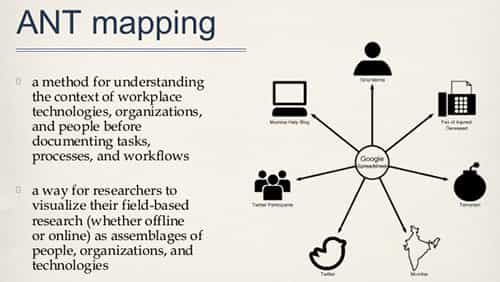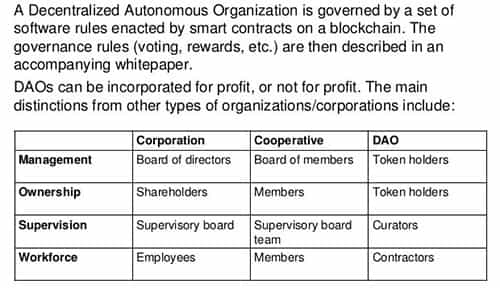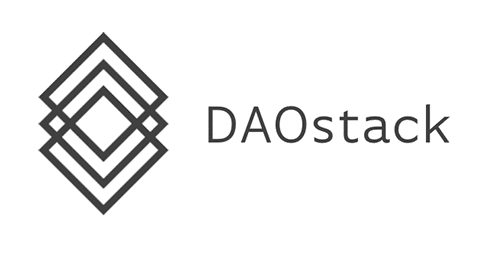DAOStack: Everything you Need to Know About Blockchain Governance
One of the most interesting projects that will soon be launching an ICO is the DAOStack. This will provide a standardized and comprehensive framework for building Decentralised Autonomous Organisations (DAOs).
DAOs are one of the most interesting use cases for blockchain technology in that they provide the means for large groups of individuals to cooperate in a transparent manner.
The ability to cooperate in large numbers of individuals and groups has been the most powerful force driving the evolution of complex societies and one that has enabled human species to survive throughout thousands of years. As Friedrich Hayek once put it
The curious task of economics is to demonstrate to men how little they really know about what they imagine they can design
From small hunter-gatherer bands to alliances along tribal lines, to organized religion, nation-state building and the keeping of empires together, the history of human species can be seen as one of the continuous evolution of cooperation and social coordination in the face of changing circumstances under scales of transformation.
Blockchain Governance and Why It Matters
In the wake of the 2008 global financial crisis, blockchain technologies and public distributed ledgers brought about a new framework within which it seemed possible to more efficiently and fairly coordinate (economic) social activity on a scale transcending geographic borders, cultural barriers and confidence-eroded institutional jurisdictions.
However, the new language of the solutions came with their own sets of problems which, in the ongoing process of further refining the right questions, have converged together a host of technologies.
And the relationships between the quantitative domain of absolute order and the qualitative one of flexible democratic organization are beginning to crystallize with the presently ongoing debates on blockchain governance in how these relationships ought to be aligned so as to prevent the replication of the mistakes the very paradigm of DLT set out to resolve in the first place.
Or as Vlad Zamfir put it, since technology is neither good nor bad, but always neutral, blockchain governance is perhaps the
most important factor that will determine whether blockchains end up being a public good, or a menace to the public
Actor-Network Theory
Before delving further it may be useful to define some common terms used in the crypto-economic realm of systems design in order to provide а broader context for reasoning about the issues at hand.
Actor-network theory is a methodological and descriptive (rather than prescriptive) approach to social science that posits everything in both the social and natural world to exist in ever shifting networks of complexly intertwined relationships.
Pioneered by Bruno Latour, the intuitions and basic notions of the actor-network approach are well suited and applicable for the situational analysis of how "material-semiotic" networks assemble, shape themselves and act together as a whole.
What is an Agency?

ANT doesn't privilege human actors over non-human ones, but instead sees humans, technology, science and culture as entangled in complex webs of shifting relations. The concept of agency and what constitutes an agency is particularly relevant to the matter at hand.
ANT scholars locate agency neither in human “subjects” nor in non-human “objects” as such, but in the heterogeneous associations of humans and non-humans. A plethora of unknowably large multiplicity of different realities and "worlds" exists – one for each actor’s sources of agency and his motivations and inspirations for action.
An agency thus becomes the result of translating back and forth for a hybrid collective which constitutes an array of relations, links, inter-penetrations and processes. The collective includes all that it inspires, influences and touches it and all of the actors within this network are equal in performing their inscribed roles. The sense of an organism — an autonomous entity, is an emergent phenomena apparent only at the collective level of the ensemble.
Machines on the other hand are very good allies (political and otherwise) as their immutability and inertia (i.e., lack of opposition to them) makes them very efficient in keeping other allies in place, making the dominating actors look stable and solidifying a set of arrangements and relationships.
And since we are leaning on technology to reliably replace otherwise unreliable human activities, it is important to consider these factors without fixating on either one component exclusively, but striving to zoom out in acquiring a more panoramic view of the overall landscape.
Decentralized Autonomous Organizations

The open, programmable accounting system of blockchains naturally extended to the invention of the so-called Decentralized Autonomous Organizations (DAOs). A DAO is a form of organization running on the blockchain. The fundamental rules of the DAO are collectively agreed upon in accordance with the goals and purposes of that organization and encoded in software, thereby limiting the necessity for human managerial activity.
A notorious example and the first such experiment was the venture capital funding DAO on Ethereum which launched in June 2016 and was hacked and drained of 50 million US dollars worth of Ether quickly thereafter. This resulted in a blockchain split and leaving the unforked chain as Ethereum Classic (ETC).
At present, an example of a functioning DAO agency formed around shared interests and competence that is running on the Ethereum platform is MakerDAO. MakerDAO developed around the aim of designing a currency and risk management platform allowing for the engineering of stability mechanisms.
Stability is no doubt attractive in the currency markets where volatility can impact returns. In that endeavor, MakerDAO has formed an active and vibrant community attracting diverse kinds of people with commonly shared interests in complementing skills and knowledge and coordinating efforts together.
In contrast and more broadly, formalized on-chain governance can quickly derail to a pull towards disinterested inertia (as the inherent quality of technology, as in the language of ANT) and rule of plutocracy (single point of control is also single point of failure).
Instead, governance should be understood as an organic process hinging on the active participation of involved players. These players should produce decisions that affect states of affairs in regards to governing resources.
This is because these decisions often trigger cascades of systemic consequences in complex dynamic systems such as those constituting global distributed ledgers with their consensus engines.
DAOStack

The DAOStack project, which was developed by a team from Israel's Technion, tackles the convoluted affairs of blockchain governance and is dedicated to instituting an open, modular platform and operational stack for programmatically deploying DAOs. The unit of governance is an agency or a DAO and it allows for configuring or choosing the best governance model suitable for a given organization and implement it using the DAOStack base layer.
The base layer (a smart contracts engine called Arc) is a universal framework for decentralized governance and collective value management over the blockchain. It was designed so that it ensures cohesive resistance to concentration of decision making power in the hands of a few. This is done while maintaining flexibility under changing conditions and preserving alignments of interests and trust among the parties involved.
That way the possibility of large scale systemic failure is locally contained and prevented from propagating and destabilizing larger segments of the network (or worse, spilling over into another frontier of geopolitical economic warfare).
The tension between scale and resilience is resolved in DAOStack by crypto-economically monetizing the gaps between the status quo and (subjective) truth. This is done via the utility function of the GEN token in promoting proposals and calling for attention. This is regulates the rate at which proposals are submitted.
The rate is regulated as the more proposals arrive in given period, the more expensive they become; the more at stake, the more attention and involvement it naturally attracts. The underlying design rationale of DAOStack attempts to abstract and combine the general principles of market efficiency at scale with the cohesion and orientation of small companies, organizations and firms.
Holographic Consensus
Inter-subjective or holographic consensus is achieved on the level of localized assemblies (e.g., subcultures, smart agencies, etc.) which allow certain subgroups within its organization to make decisions under certain specified conditions. These could be, for example, delegation under defined constraints analogous in principle to off-chain computations in guaranteeing data integrity, e.g. as in zkSNARKs and stamped authenticity proofs in the case of oracles.
This approach allows for an exponential trajectory of extreme fractal federal-governance mode. The foundational DAO branches into other DAOs as it goes from the general to the concrete and instead of central management there is direct or indirect coordination between agents.
The DAOStack Genesis DAO launches on the Ethereum mainnet with the goal of enabling large-scale cooperation by beginning to allocate GEN tokens to builders and early adopters. This will be done by gradually creating super-scalable self-organizing networks via the holographic consensus governance protocols.
Use Cases and Applications
One of the first DApps to launch on DAOStack is Alchemy, a collaborative application and decentralized budgeting platform for open source projects, a demo of which by DAOStack's CEO Matan Field can be found here.
Holochain have also launched an ICO (Holo) which aims to leverage agent-centric distributed computing. This will create the conditions for a communications ecosystem of incentivized mesh networks and communities.
Conclusion
DAOs are one of the culminative achievements of Distributed Ledger Technology that have been in the making for the past several years.
They form the blueprint for the resolution of many problems at present, including the susceptibility to cartel formations and the gradual closing of the floodgates of scam driven ICOs and quick profit seeking plagiarism.
DAOs can help move us towards a more constructive, collaborative and socially oriented paradigm of collectively managing resources in a more forward oriented and fairly distributed manner.
Disclaimer: These are the writer’s opinions and should not be considered investment advice. Readers should do their own research.

